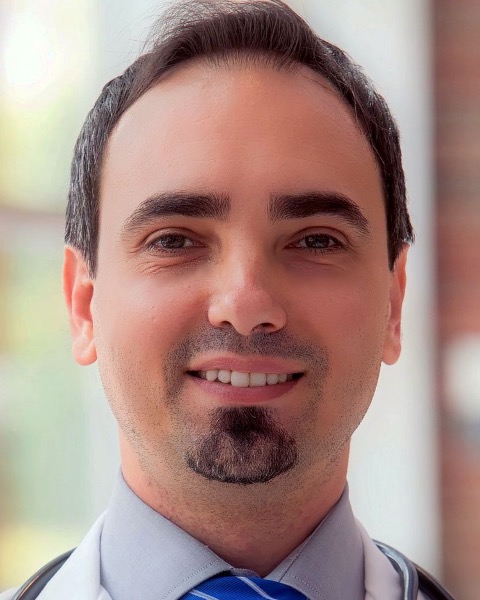Quick Fire Cases
A Startling Discovery: The Case of a Giant “Silent” Cardiac Tumor (QF_TH_042)
- MM
Marzia Maltempi, MD
Cardiology Fellow
University Hospital of Perugia, Italy - SS
Stefano Sforna, MD
Cardiology Consultant
University Hospital of Perugia, Italy - EG
Elisabetta Girella, MD
Cardiology Fellow
University Hospital of Perugia, Italy - BG
Bianca Maria Gattari, MD
Cardiology Fellow
University Hospital of Padua, Italy - FM
Francesco Giovanni Marchese, MD
Cardiology Fellow
University Hospital of Padua, Italy - GB
Giulia Brunello, MD
Consultant Cardiologist
University Hospital of Padua, Italy - LN
Luca Nai Fovino, MD
Consultant Cardiologist
University Hospital of Padua, Italy - EC
Erberto Carluccio, MD
Consultant Cardiologist, Chief
University Hospital of Perugia, Italy - FG
Francesca Garinei, MD
Chief Radiology Division
Hospital of Todi, Umbria, Italy, Italy - DM
Daniela Mancuso, MD
Consultant Cardiologist
University Hospital of Padua, Italy - VP
Valter Papa, MD
Chief Radiology Division
Regional Healthcare Unit, Umbria, Italy, Italy 
Andrea Cardona, MD, PhD, FACC, FSCMR
Chief Advanced Cardiovascular Diagnostics – Regional Healthcare Unit, Umbria
Regional Healthcare Unit, USL Umbria, Italy, Italy
Andrea Cardona, MD, PhD, FACC, FSCMR
Chief Advanced Cardiovascular Diagnostics – Regional Healthcare Unit, Umbria
Regional Healthcare Unit, USL Umbria, Italy, Italy
Co-Author(s)
Presenting Author(s)
Primary Author(s)
A 20 year-old asymptomatic male, without any significant past medical history, was referred to our advanced CV imaging center for the incidental detection of a suspected cardiac mass by transthoracic echocardiography performed during a routine sport cardiology evaluation. Exercise bicycle test and ambulatory ECG monitoring were unremarkable.
Diagnostic Techniques and Their Most Important Findings: CMR showed a giant ovoid cardiac mass (95x69x60 mm) originating from the myocardium and located into the lateral, anterior and inferior medium-basal walls. While the geometry of the mitral annulus was compromised as per CINE imaging evaluation, mitral leaflets motion was preserved and there was no evidence of outflow or inflow tract obstruction (Fig. 1, panels A-B). Left ventricular systolic function was normal, while volumes were slightly increased (LVEF = 59%, LEDVI = 126 ml/m2). For tissue characterization, with the short tau inversion recovery-T2-weighted (STIR-T2W) and the white blood-T2W sequences the mass appeared hypointense, which excluded a cardiac cyst, while with the black blood-T1W sequence it appeared iso/hypointense, which ruled out adipose tissue (Fig. 1, panel C). Myocardial first pass perfusion sequences showed only mild enhancement in the mass which excluded hyper vascularization (Fig. 1, panel D). Conversely late gadolinium enhancement (LGE) depicted a strong enhancement (Fig. 1, panels E-F). These characteristics, compatible with a low malignant and mesenchymal tumor, suggested the diagnosis of giant myocardial fibroma. Subsequently, a coronary angiography was performed which showed normal coronary arteries, no direct mass vascularization, but a dislocated anatomy of the obtuse marginal branch (Fig. 2). The heart team decided for myocardial biopsy, that was not performed according to patient’s will. Due to likely benign nature, absence of symptoms, and high surgical procedural risk, close clinical and instrumental follow up was indicated, including a follow-up CMR. A second CMR was performed after 3 months. Mass dimensions and tissue characteristics were unchanged (Fig. 3, panel A). Despite normal LV systolic function, unchanged volumes (LVEF = 64%, LEDVI = 122 ml/m2), and no hemodynamic impairment, CMR-strain analysis showed that the global circumferential strain was slightly reduced (-15.6%) due to pathological movement of the walls infiltrated by the tumor. In particular, the entire inferior and lateral basal segments showed a pathological circumferential strain as depicted by bull’s eye polar map and strain curves (Fig. 3, panels B-D).
Learning Points from this Case:
CMR, together with cardiac CT, are widely recognized as the gold standard non-invasive imaging modalities for cardiac mass evaluation. However, in particular and rare cases like this, CMR offers superior power allowing not only to provide critical information regarding mass tissue characterization, localization, dimensions, and relation to surrounding structures, but is capable to accurately assess hemodynamic involvement and can be used as close follow-up assessments without radiation exposure. While the definitive diagnosis requires histological analysis, in this case endomyocardial biopsy could not be performed and surgical risk was consider too high at the present stage. Therefore, CMR was chosen as the preferred imaging modality to follow-up closely the natural history of this cardiac tumor.

